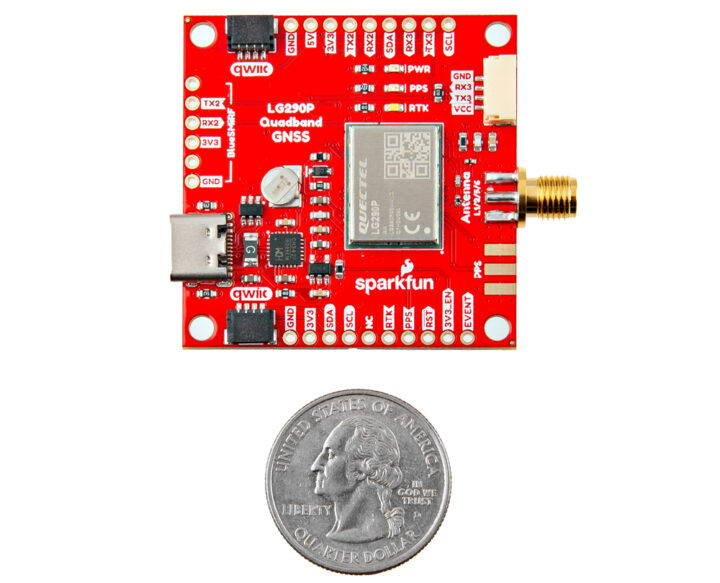SparkFun has released the Quadband GNSS RTK Breakout featuring the Quectel LG290P module designed for high-precision real-time kinematic (RTK) applications. It supports GPS, GLONASS, Galileo, BDS, QZSS, and NavIC constellations, with the ability to simultaneously receive signals from L1, L2, L5, and L6/E6 frequency bands. The module includes support for SBAS augmentation systems (e.g., WAAS, EGNOS, GAGAN) and PPP services (e.g., BDS PPP-B2b, QZSS CLAS), delivering reliable positioning with fast convergence times for precision navigation tasks.
The breakout board offers a compact design (43.2 x 43.2mm) and multiple expansion options including 24 PTH pins, dual 4-pin JST Qwiic connectors, three UART interfaces, a USB-C connector, and additional PTH pins for BlueSMiRF/Serial-to-UART. With its RTK support and advanced GNSS capabilities, the board is ideal for applications requiring high-accuracy positioning and robust navigation performance.
Previously, we covered several GNSS boards including the SparkFun GNSS L1/L5, u-blox EVK-LEXI-R10, and Conexio Stratus Pro and GNSS modules such as the Cavli C17QS and Cavli C16QS, but quad-band GNSS modules are less common with the only other we’ve written about is the u-blox X20 with u-blox F9 pin-to-pin compatibility.
,
SparkFun Quadband GNSS RTK Breakout specifications:
- GNSS module – Quectel LG290P
- GNSS Frequency bands
- GPS – L1 C/A, L1C, L5, L2C
- GLONASS – L1, L2
- Galileo – E1, E5a, E5b, E6
- BDS – B1I, B1C, B2a, B2b, B2I, B3I
- QZSS – L1 C/A, L1C, L5, L2C
- NavIC – L5
- SBAS – L1 C/A
- L-band PPP
- PPP – B2b
- QZSS – L6
- Galileo HAS – E6
- Tracking Channels – 1040
- Horizontal Position Accuracy
- Autonomous: 0.7m
- RTK: 0.8cm + 1ppm
- Vertical Accuracy
- Autonomous: 2.5m
- RTK: 1.5cm + 1ppm
- Time to First Fix (without AGNSS)
- Cold Start: 28s
- Warm Start: 28s
- Hot Start: 1.7s
- Sensitivity
- Acquisition: -146dBm
- Tracking: -160dBm
- Reacquisition: -155dBm
- Interfaces – UART, SPI, I2C
- GNSS Frequency bands
- GNSS Constellations – GPS (USA), GLONASS (Russia), Galileo (EU), BDS (China), QZSS (Japan), NavIC (India)
- SBAS Systems – WAAS (USA), SDCM (Russia), EGNOS (EU), BDSBAS (China), MSAS (Japan), GAGAN (India)
- Anti-Jamming – Built-in professional-grade NIC
- Antenna
- SMA connector
- SMA connector for PPS output
- USB – USB Type-C connector for power and communication with the LG290P GNSS receiver
- Expansion
- 24x PTH pins with I2C, UART, RTK, +5V, +3.3V, and GND
- 2x 4-pin JST Qwiic connector
- 4-pin locking JST connector
- Misc
- Red 3.3V power LED
- Yellow Pulse-Per-Second LED
- White RTK correction LED
- Various jumpers
- VSEL jumper (short 3.3V by default) – This jumper can be modified to configure/disconnect the VCC pin of the 4-pin locking JST connector to/from 3V3 or 5V power
- BT_VCC jumper (closed by default) – This jumper can be cut to disconnect the 3V3 BlueSMiRF header pin from the 3.3V output of the RT9080 LDO regulator
- PWR jumper (closed by default) – This jumper can be cut to remove power from the red, power LED
- PPS jumper (closed by default) – This jumper can be cut to remove power from the yellow LED (PPS signal)
- RTK jumper (closed by default) – This jumper can be cut to remove power from the white LED, indicating RTK fix or operation in RTK mode
- PPS-DC jumper (closed by default) – This jumper can be cut to disconnect the pulse per second signal from the PTH pin
- SHLD jumper (closed by default) – This jumper can be cut to disconnect the shielding of the USB-C connector from the GND plane of the board
- Power supply
- 5V input via Type-C USB
- RAW PTH pin (pins: 3V3, 5V, 3V3_EN, GND)
- JST Qwiic and locking JST connector
- Backup battery to aid in hot starts
- Dimensions – 43.2 x 43.2 mm
The SparkFun Quad-band GNSS RTK Breakout features a 6-pin PTH BlueSMiRF header for UART2 communication, compatible with devices such as UART adapters, serial data loggers, and BlueSMiRF transceivers. It uses the CH342 USB-to-Serial converter, with USB drivers available on the WCH website. To configure the Quectel LG290P GNSS module, Quectel’s QGNSS software is recommended for managing the module’s unique UART command structure. For macOS and Linux users, alternative software can display NMEA messages but is limited to data reception and does not support module configuration. More details are provided in the Software Overview section on Sparkfun documentation website and on GitHub.
The SparkFun Quadband GNSS RTK Breakout is an open-source product with schematics, Gerber files, firmware, and detailed documentation available on the product page and the Hookup Guide. The SparkFun Quadband GNSS RTK Breakout board can be purchased on SparkFun’s official store for $149.95.

Sayantan Nandy, an electronics engineer with over four years of hands-on experience in PCB design, circuit development and power electronics, is proficient in EAGLE CAD, Ki-Cad, and Altium. He has a proven track record of delivering efficient and effective systems. His expertise extends from R&D, and prototyping to production support, making him a valuable asset to any engineering team.
Support CNX Software! Donate via cryptocurrencies, become a Patron on Patreon, or purchase goods on Amazon or Aliexpress






